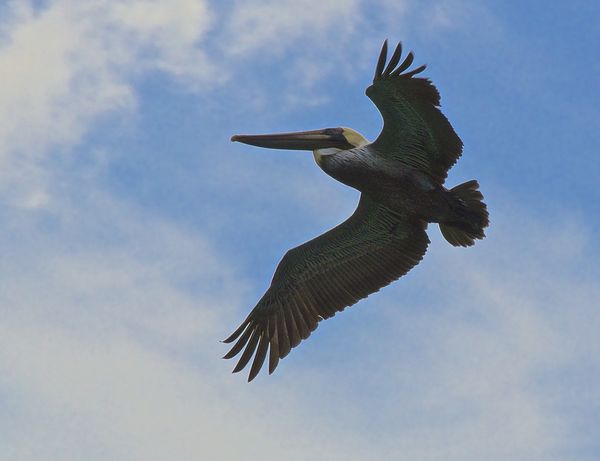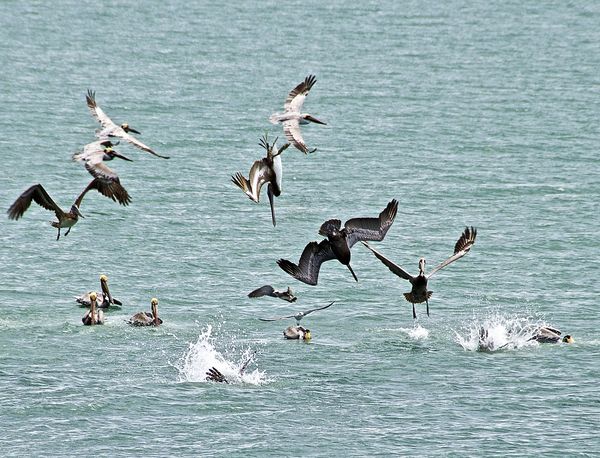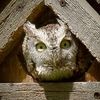Shooting Bird(s), focus mode to select
Jan 23, 2015 21:37:21 #
Last Sunday was a great day to go down to Old Fort Amador and shoot pelicans, in Panama City (the one with the canal). Equipment: Nikon D7000 w/18-200mm kit lens.
I shot some with auto-focus single servo (AF-S), some with auto-servo (AF-A). I mostly shot manual and sometimes Shutter, at 1/500 or more.
Question: Which auto focus setting to use? The lone pelicans I shot AF-S. The groups, AF-A. When there's a group of birds like these, what's the best focus option to use for optimum focus?
I'm attaching 2 files for reference.
Thanks, for comments. Val
I shot some with auto-focus single servo (AF-S), some with auto-servo (AF-A). I mostly shot manual and sometimes Shutter, at 1/500 or more.
Question: Which auto focus setting to use? The lone pelicans I shot AF-S. The groups, AF-A. When there's a group of birds like these, what's the best focus option to use for optimum focus?
I'm attaching 2 files for reference.
Thanks, for comments. Val
Jan 23, 2015 21:55:45 #
When shooting birds I use Auto Focus Mode AF-C, and Release Mode CH (continuous high) with VR off, and a fast shutter speed---at least 1/500, but I prefer 1/1000. I also use Spot Metering. I hope this helps.
The pelican in #1 is a nice shot, great detail in the wings. #2 would probably benefit from a CP filter.
The pelican in #1 is a nice shot, great detail in the wings. #2 would probably benefit from a CP filter.
Jan 23, 2015 22:01:10 #
Generally, for moving subjects, AF-C, continuous auto focus, will work very well. Restricting the number of AF points to either one or a small cluster of points helps the AF system to focus precisely on the bird. If possible, place the AF sensor on the bird's eye or head. Or, if you are having a problem with keeping it on the eye then just focus on the breast or body. At f/8 or so, you will have sufficient Depth Of Field to get everything, including the wings in focus.
When shooting a large group of birds, as in your second picture, you should pick out one bird near the center of the group and focus on it. If you don't, then you don't have any idea where the camera will be focusing. Secondly, Depth of Field can become an issue is the birds are scattered at different distances. In which case, shooting at f/16 may be needed.
Visit our special section devoted to birds-in-flight and read this discussion regarding this very subject. http://www.uglyhedgehog.com/t-276885-1.html
When shooting a large group of birds, as in your second picture, you should pick out one bird near the center of the group and focus on it. If you don't, then you don't have any idea where the camera will be focusing. Secondly, Depth of Field can become an issue is the birds are scattered at different distances. In which case, shooting at f/16 may be needed.
Visit our special section devoted to birds-in-flight and read this discussion regarding this very subject. http://www.uglyhedgehog.com/t-276885-1.html
Jan 24, 2015 06:19:18 #
Mac wrote:
When shooting birds I use Auto Focus Mode AF-C, and Release Mode CH (continuous high) with VR off, and a fast shutter speed---at least 1/500, but I prefer 1/1000. I also use Spot Metering. I hope this helps.
The pelican in #1 is a nice shot, great detail in the wings. #2 would probably benefit from a CP filter.
The pelican in #1 is a nice shot, great detail in the wings. #2 would probably benefit from a CP filter.
I love to photograph birds and have done so with a D3100 using AF-C mode. Now I have a new D7100, would you use the single, 9 or 21 sensor setting with the AF-C mode??? Also, when if ever would you use the 3D mode. I have just used it playing around. Is there a real life application or just use the AF-C mode as discussed for birds above.
Jan 24, 2015 07:20:37 #
Jan 24, 2015 08:51:05 #
Jan 24, 2015 08:53:36 #
Thank you All for your comments and references. The pelicans ain't going away so now I have a bit more tech info for the next encounter.
Jan 24, 2015 10:40:52 #
Revet wrote:
I love to photograph birds and have done so with a D3100 using AF-C mode. Now I have a new D7100, would you use the single, 9 or 21 sensor setting with the AF-C mode??? Also, when if ever would you use the 3D mode. I have just used it playing around. Is there a real life application or just use the AF-C mode as discussed for birds above.
Revet, 3D is good for landscapes, buildings, fairs, etc. For birds I think that spot metering (・) is best. As Birdpix pointed out, it is important to have the eye in focus as much as possible, and that an f/8, f/11, f/16 will increase the DoF.
Jan 24, 2015 11:54:15 #
The Pelican in the first photo is underexposed because when you took the photo, the camera meter saw the bright sky and stopped down 1.5 to 2 stops. Next time when shooting up into a bright sky, add 1-1/2 stops exposure compensation or set the exposure mode to manual and overexpose that way, but remember when you again point the camera at the land to reset your exposure. Bright water will give similar metering problems. It's always best to experiment before the birds come. A white bird against a bright sky needs less compensation. Experiment.
Jan 24, 2015 12:21:27 #
Mac wrote:
Revet, 3D is good for landscapes, buildings, fairs, etc. For birds I think that spot metering (・) is best. As Birdpix pointed out, it is important to have the eye in focus as much as possible, and that an f/8, f/11, f/16 will increase the DoF.
Yes, it is important to have the eye in focus, in fact, I usually reject any photo with a blurry eye.
The point I was trying to make was that the eye should be the target that we place the AF point on, if possible. If it is not, such as when birds are farther away, small, or erratic in flight that we should try to focus on the body or breast of the bird as that is usually near the same distance as the eye. With either the eye or the breast as the target then depth of field becomes less of an issue because, at the normal distances that we shoot BIFs even f/5.6 is often enough. Using a DOF calculator for your camera/lens combo will tell you how much you have. For example my 7D and 500mm lens at f/8 has about 15 inches of DOF at 60 ft. http://dofmaster.com/
My reference, in the earlier post, to DOF was in relation to shooting flocks of birds where the birds are at very different distances and in order to get more of them in focus, f/16 may be more useful. In the above example, the DOF would increase to 30 inches or so.
One component of getting sharp BIF photos that may be more important than the number of focus points or f/stop used is shutter speed! My experience has been that the higher the speed the sharper the photos will be. Panning with a moving bird introduces a lot of camera movement relative to the bird AND the bird is moving, not just forwards, but up and down with the wing beats. For me, 1/2000 becomes my basic shutter speed and, if the light allows, I will go up to 1/4000. That puts a real strain on the capabilities of your equipment because you are then shooting at f/8 or f/5.6 at ISO 800 in bright sun. What do you do on a cloudy day? Do you increase ISO? Or do you decrease shutter speed?
Here is a flock of Dunlin shot at f/8. It was a quick shot and I didn't have time to adjust my aperture for greater DOF.
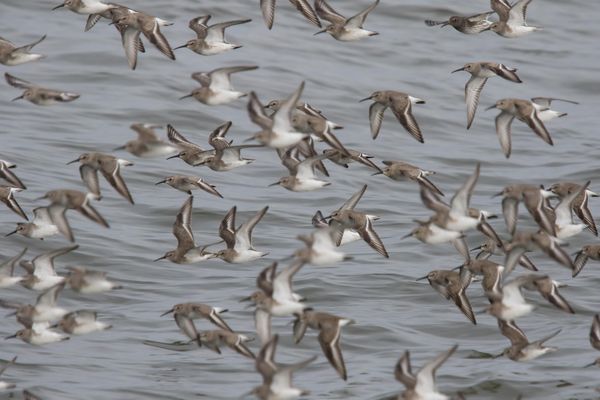
(Download)
Here is the same flock banking, again at f/8. During the turn, the flock flattened out so more of the birds are in focus. Greater distance also increased DOF.
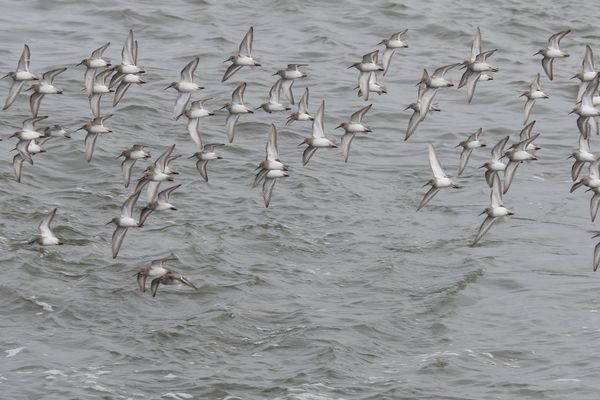
(Download)
Jan 25, 2015 05:05:22 #
If you went to a museum or looked in my Sony bag you would see several old M42 lenses. Old lenses had a focus ring that gave distance, for a 200mm the marking for 200' and infinity was not much. The DOF at f8 is 100' to infinity. New lenses are not much if any different from the old lenses except for showing us what is going on and not allowing for informed control. i.e. Laws of optics are unchanging.
The exposure is auto set by the brignt sky... ooops bird is under exposed, so set aperture at 8 or greater and speed high in combo with the ISO to get desired exposure. That can be done with a dummy target.
What I am saying in summary is that rational, knowledgeable, use "your-brain" may well be better than trusting the camera to make a quick decision on a rapidly changing situation. Often a set of "good parameters" will fit most situations, be it flowers or birds, twitching from that setting depends on the specific.
"Ain't Nuthen Wrong With Manual Settings"
The exposure is auto set by the brignt sky... ooops bird is under exposed, so set aperture at 8 or greater and speed high in combo with the ISO to get desired exposure. That can be done with a dummy target.
What I am saying in summary is that rational, knowledgeable, use "your-brain" may well be better than trusting the camera to make a quick decision on a rapidly changing situation. Often a set of "good parameters" will fit most situations, be it flowers or birds, twitching from that setting depends on the specific.
"Ain't Nuthen Wrong With Manual Settings"
Jan 25, 2015 11:00:26 #
birdpix wrote:
Yes, it is important to have the eye in focus, in ... (show quote)
Birdpix, Thank you for this information. I had not thought of using the body in certain situations as the focal point, that the body and head/eyes being in close proximity. I mean I knew it, I just didn't think about it. I will use this when necessary. Also I will try using a shutter speed of 1/2000 and higher.
Jan 25, 2015 14:04:01 #
dpullum wrote:
If you went to a museum or looked in my Sony bag y... (show quote)
I agree, there is nothing wrong with manual settings for exposure. I use manual most of the time. I do not agree that manual is the way to go for me for focusing. I completely understand the concept of predictive focus and hyperfocal distance but, my 500mm lens has only 3.65 feet of DOF at f/8 at 100 feet. I am often shooting at shorter distances with even less DOF. Hyperfocal distance just doesn't cut it. That is, unless, you can predict the location of your subject with a very high degree of precision.
The autofocus systems on most modern cameras are good enough that, I believe, they can result in a much higher percentage of in-focus shots when tracking moving subjects than focusing manually. This does require a knowledge of your camera's AF system and what settings will result in the highest percentage of sharply focused shots given the situation at hand.
The OP's question was about which AF mode to select for shooting birds-in flight. Although some of us have gotten a bit off the track at times, I think we have given him what he needs to be successful.
Jan 25, 2015 14:09:26 #
Revet wrote:
I love to photograph birds and have done so with a D3100 using AF-C mode. Now I have a new D7100, would you use the single, 9 or 21 sensor setting with the AF-C mode??? Also, when if ever would you use the 3D mode. I have just used it playing around. Is there a real life application or just use the AF-C mode as discussed for birds above.
I would use the single point if you are comfortable with it or the 9 point. I am not a Nikon shooter so I don't understand the difference between AF-C and 3D modes. Hopefully a Nikon owner will pipe in.
Jan 25, 2015 14:11:50 #
quenepas wrote:
Good advise. I did forget switch the lens to m.
Thanks.
Thanks.
I'm not sure who or what you are referencing here but switching the lens to "M" puts it into manual focus.
If you want to reply, then register here. Registration is free and your account is created instantly, so you can post right away.

